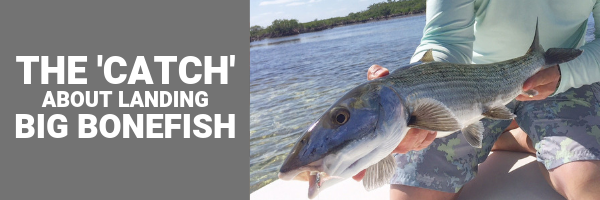Bringing a big bonefish in is exciting.
Although size and quality don’t always go hand in hand, size is often considered a top determining factor in whether or not a catch is actually prize or pride-worthy. Bigger bones, however, have different attitudes and habits than small bones and thus, catching them requires more stealthy techniques. At the end of the day, these giants tend to be smarter and more adept at avoiding capture than their younger, smaller counterparts.
Cruising Fish Are Usually Led By The Largest Fish
Cruising fish, whether traveling in small pods or large schools, are usually led by the biggest bones. If you’re casting to multiple fish, particularly when you aren’t able to make each bonefish out individually, try targeting the leader. In most cases, the leader is going to be the biggest bone in the group.
Bigger Flies = Bigger Fish
Big bonefish tend to be most responsive to flies that plunge hard and settle at the bottom. If you’re fly is too light, big bones will quickly rise up in the water column, even after giving you a good follow. Think about changing your flies throughout the day, based upon the current conditions rather than fish patterns. Given that bigger bones tend to maintain a zig-zag pattern when feeding, you should additionally try throwing as close to these fish as possible.
Choose Your Leader Wisely
Always go for a heavier leader whenever hunting big bonefish. After all, you never know when a giant bone will hop on. A 12-pound nylon or fluorocarbon tippet will work well in most situations. Seasoned anglers, however, have been known to use leaders that can withstand a 16-pound test.
Land Your Fly As Close As Possible
When you land the fly close, you’ll be giving bones less of an opportunity to inspect it. This is important when pursuing larger fish. Giant bones don’t achieve their massive size through naivety. They’re smart, savvy, and quick to get away from anglers who don’t maximize every opportunity to make an inconspicuous entry. It’s also important to note that presenting closer to your target will prevent smaller fish from beating the larger bone to the fly.
Keep Your Stripping To A Minimum
You’ll find that bigger bones usually eat when the fly is still on the flat bottom. Don’t make the all-too-common mistake of over-stripping when pursuing these giants. Instead, make your first strip a quick, short bump; about three inches. This will raise the fly slightly off the bottom and then plunge it quickly back down, which closely mimics the movement of a fleeing crab. In most cases, a single, short bump will do the job.









